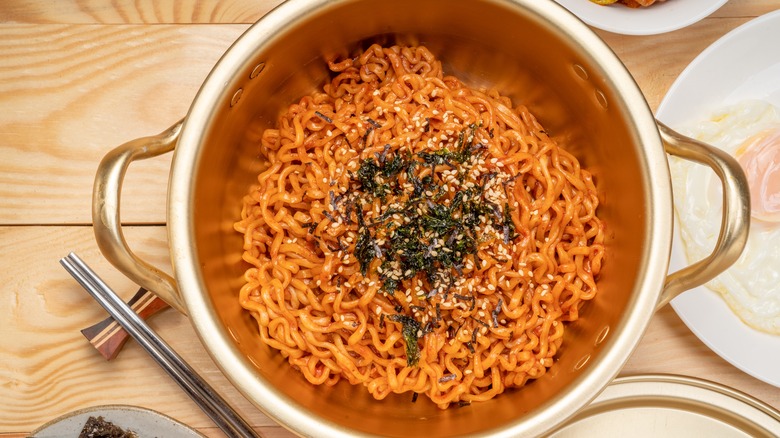The Hack Gordon Ramsay Uses To Elevate Ramen
If you love slurping ramen to your heart's content but have gotten a bit tired of your usual go-to flavors and seasonings, you can always upgrade it to something a little more gourmet. (Who doesn't love upgrades?) The king of the gourmet world himself, renowned Michelin star chef and TV personality Gordon Ramsay, has quite a few tips and tricks that are guaranteed to elevate your average, everyday meals.
There's a lot more to this beloved food guru than his on-screen strings of colorful expletives and hot-headed rants, and that's especially evident on his social media channels. As Insider noted in 2017, Ramsay is a big fan of responding to Twitter fans who request a nugget of his expertise on various food-related questions. And he loves posting video tutorials for foodies to create culinary magic at home.
If you've ever felt the urge to tweet the man about his secrets for turning mundane ramen into a more flavor-packed experience, look no further for your answer. There is a bit of prep work that goes into this recipe, so be sure you set aside some extra time if you want your noodles to achieve true greatness.
The secret is in the sauce, not the broth
In a September 23 Instagram Reel, Gordon Ramsay showed fans his step-by-step process for creating a deliciously savory plate of ramen. He starts by submerging garlic cloves in olive oil and tossing a few herbs and peppers in for an added kick before cooking them. This technique is known as confit and should take around 20 minutes of cooking at low heat on the stove for the cloves to become tender without caramelizing (per A Beautiful Plate). The "Hell's Kitchen" chef then takes a few of the now-softened cloves and places them in a small bowl with a scoop of both bean paste and chili paste before mixing them together.
Once his ramen is cooked to perfection and drained of its broth, Ramsay dumps his sauce mixture into the pot of ramen, along with a small bowl of lime juice. Commenters were curious about the lack of broth in the final product and if it could even be considered ramen when prepared this way, and the answer is yes. This no-broth style of ramen in Japan is known as "maze soba" or "abura soba," which just confirms how versatile a dish ramen has always been.
To finish off the meal, the chef chops up some green onion to sprinkle on the plated noodles and adds sesame seeds and a poached egg. Now your ramen has leveled up.

